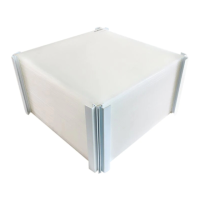2 main types of smells with the corresponding recommended
actions.
1. Freshly produced
a. Smell plastic
b. Evaporates after a few days of ventilation
c. Action: Set the ventilation device to the
highest air exchange rate when you are not
at home and repeat the process until the
odour evaporates.
2. Odour transmission (Exchange of odours in the air
currents via the membrane)
a. Smell depending on the smell transmitted
and smells from outside or from other
rooms (very critical onions and garlic,
smoke? Tar?)
b. Evaporates after a few days of ventilation
c. Action: Set the ventilation device to the
highest air exchange rate when you are not
at home and repeat the process until the
odour evaporates. (We recommend an
extractor hood, especially if there are
kitchen smells!)
In addition to odours from the inside, odours from the outside
can also get into the interior via the ventilation system. These
odours can be "picked up" by the HRV and linger for a long
time.
With HRV there can be a small amount of odour transmission
due to air exchange through leakage. However, this exchange
takes place to such a small extent that only substances with a
very low odour threshold can be perceived.
Notes radioactive noble gas radon
When uranium and radium are present in varying degrees in
all soils and rocks decay, radon is produced, which spreads
through the soil and finally reaches the earth's surface. Radon
also reaches the interior of houses from the subsoil of
buildings, where it can accumulate. This can lead to high
radon concentrations, which are hazardous to health,
especially if the room is not ventilated very often.
Radon concentrations in the soil, in the air and indoors vary
locally and regionally.
By using a ventilation system in general, you ensure that
more fresh air gets into the interior and that accumulation
with radon, which can lead to a health hazard, can be
prevented.
Notes Use on ships, coastal areas and islands
The HRV is a component for energy recovery (recuperation)
for ventilation units designed for living spaces. However, the
composition of the airflows has a strong influence on the
aging of the HRV.
Due to the increased salt content of sea air, deposits may
occur, which may affect the performance of the HRV.
We recommend cleaning the HRV with water once a year.
In addition to odours from the inside, odours from the outside
can also get into the interior via the ventilation system. These
odours can be "picked up" by the HRV and remain for a long
time.
Notes on quality control
Every single CORE HRV exchanger goes through a 100%
quality control check before it leaves our factory. Our
company is certified according to DIN ISO 9001: 2015.

